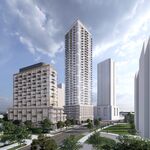smallspy
Senior Member
I guess the answer if NO - nobody know how large the platforms are, but they know that they are completely useless.
From Transit toronto (http://transit.toronto.on.ca/subway/5006.shtml)
"Lower Queen Station is also a lot shorter than a typical subway station, designed to handle a few streetcars, rather than a full subway train." There is no quantitative indication of the length.
There is no indication of any kind of the platform width.
I have not been down there, but I know quite a few people who have, including one engineer. The tunnel is a bit over 100 feet long, and the tunnels are only about 10 feet wide - just wide enough for a streetcar. The portions of "platforms" that do exist are only about 2 feet wide before they run into the cinderblock walls - the pedestrian tunnels under the subway were designed to be part of the platforms.
On top of all of that, parts of the tunnels have been repurposed for other uses - the elevators take up part of the running tunnel, as do some conduits and piping. The paid-area tunnel has been extended into the running tunnel as well.
Dan
Toronto, Ont.






